The National Academy of Science detailed the direction for astronomy and astrophysics today for the coming decade.
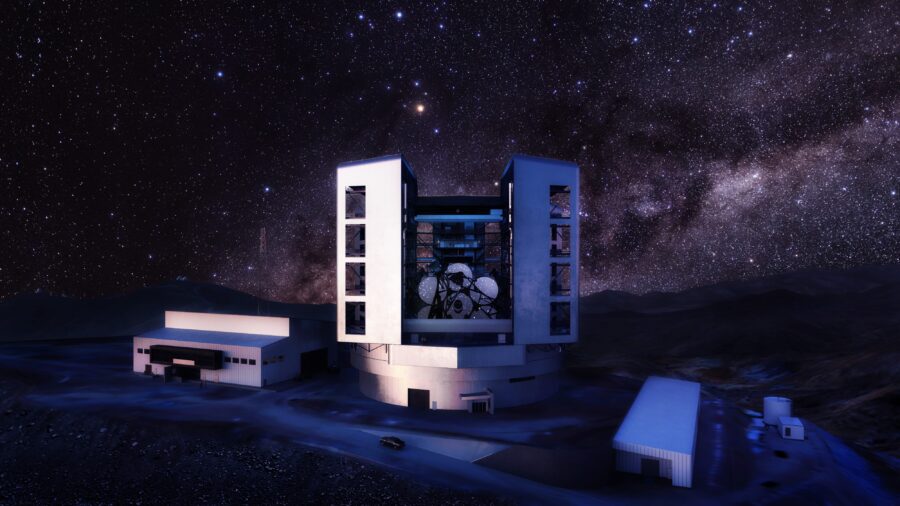
The Giant Magellan Telescope Project
Iconic space telescopes go through long pipelines from proposal to design to launch. So every decade, the space and astronomy community comes together to make recommendations for the instruments and facilities they'll need to keep pushing back the boundaries of discovery. The outcome, known as the Decadal Survey on Astronomy and Astrophysics, is a big deal for the astronomical community, as it provides the marching orders for the coming decade and beyond.
On Thursday, November 4th, the National Academies of Sciences, Engineering and Medicine released the long-awaited, 614-page report. Titled “Pathways to Discovery in Astronomy and Astrophysics for the 2020s” (dubbed Astro2020 in more informal settings), the report relied on advice from 867 white papers, several public information-gathering sessions, and 13 expert panels to form its recommendations.
The item that will no doubt receive the most fanfare is the report's recommendation that NASA pursue development of a space telescope, with a mirror at least 6 meters wide, that will see in infrared, visible, and ultraviolet light. That means that of the flagship mission concepts that competed for priority, visible light won out over X-ray and far-infrared observatories. But these are still on the list, they'll just have to wait longer for development.
“This is a visionary road map for the future of discovery,” says Grant Tremblay (Center for Astrophysics, Harvard & Smithsonian), member of the Lynx mission concept proposal. “I’m utterly grateful that the committee has shown an achievable and maximally ambitious path toward a new constellation of Great Observatories.”
“We are excited that the vision of Lynx will embark on a journey toward flight as part of the Great Observatories Technology & Mission Maturation Program,” he adds. “Alongside our friends and colleagues on the LUVOIR, HabEx, and Origins mission concepts, we are committed to the success of this journey. This is the first day of an entirely new epoch of discovery, and the New Great Observatories are poised to answer the greatest questions that lie before us.”
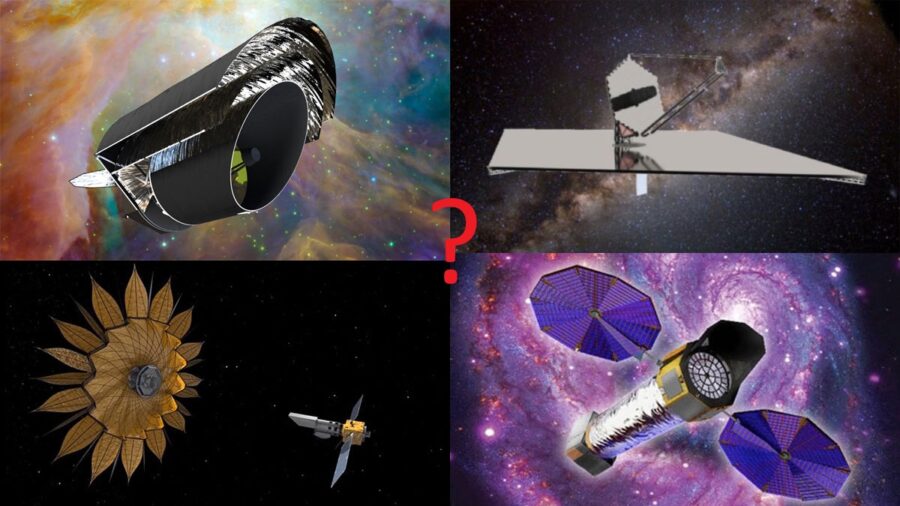
NASA
In a first for decadals, in this survey there was also a panel focused not on facilities but on people. The result is a call for investment in workforce diversity, guaranteeing that policies are in place to deal with harassment, discrimination, and misconduct. Specifically, the report names the racial diversity among astronomy faculty “abysmal.” Since the problem was first identified in the 1980 decadal survey, the numbers have remained largely unchanged: Currently, 1% of faculty are African American and 3% Hispanic. To address this, the report recommends increased funding incentives to improve diversity in astrophysics and astronomy faculty.
It's worth noting that the COVID-forced delay means that the recommendations in this report will miss the congressional reconciliation bill currently on the Senate floor, and they may not be part of the President’s FY 2023 budget request. For this reason, the report's recommendations start in 2023.
Science Goals for the Next Decade
The scientific vision in the survey is laid out in three broad themes aimed at enabling key discoveries in astronomy and astrophysics:
- Worlds and Suns in Context will build on our understanding of exoplanet science by characterizing planetary systems around other stars and looking for potential Earth analogs. To this end, the report prioritizes imaging and obtaining spectra from potentially habitable exoplanets.
- New Messengers and New Physics will use time-domain observations across multi-messenger observations (electromagnetic spectrum, gravitational wave, and particle physics) to probe the nature of inflation, dark energy and dark matter. By combining multi-messenger observations, astronomers will obtain new windows on exotic sources including black holes, neutron stars, and explosive merger events.
- Cosmic Ecosystems will work to connect working models of star formation and galactic evolution with specific processes, to determine their past and ultimate future. The prime motivation is to understand how galaxies grow by looking at how gas drives stellar formation, and in turn, galactic evolution.
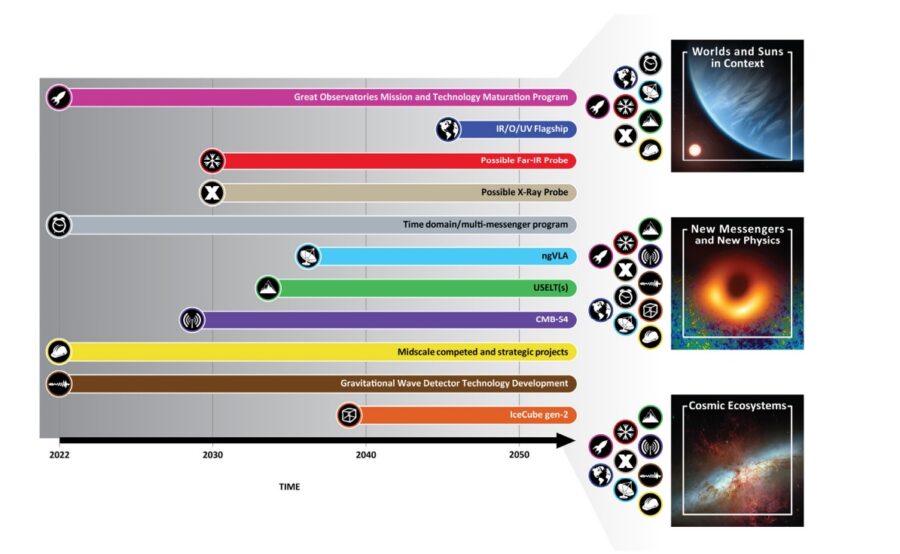
National Academies of Sciences / Astro2020 Decadal Survey
And the Winner Is...
In a change from previous surveys, Astro2020 is advocating the development of a “Great Observatories Mission and Technology Maturation Program.” This program would guide the development of key technologies and missions before committing to specific mission concepts. One only has to look at the convoluted paths of missions such as the James Webb Space Telescope, set to launch in December after more than a decade of delays, to realize just how complex the process can be.
The first item on the wishlist — and the first to enter the maturation program — will be a large, 6-meter (20-foot) aperture telescope capable of imaging in infrared, visible, and ultraviolet light. This selection focuses on the exoplanets science theme, basically compromising between two flagship proposals that went into the decadal: The 4-meter HabEx proposal and LUVOIR, which was proposed as 8-meter and 15-meter configurations. This flagship mission would cap out at $11 billion through the first five years of operation, with a launch in the early 2040s.
The next items on the wishlist are both X-ray and far-infrared observatories, which would serve as successors to Chandra and Herschel, respectively. These observatories correspond to the Lynx and Origins mission concepts, recommended to the tune of $3–5 billion.
Ground-based Astronomy
In terms of ground-based observatories, the report gives high priority to both the Giant Magellan Telescope (GMT) and the Thirty-Meter Telescope (TMT), which it recommends join forces as the Extremely Large Telescope (ELT) project. Curiously, though the report cites both telescopes as essential, it also mentions that the success of the ELT program hinges on the completion of “at least one” of these telescopes. The GMT will be based in Chile, and the TMT will be built on either Mauna Kea, Hawai’i, or on La Palma, Spain.
The NSF and DOE will also pursue a project known as Cosmic Microwave Background Stage 4. This observatory will carry out a 7-year sky survey from the South Pole in the 30-270 GHz range in tandem with all-sky surveys carried out from the Atacama desert in Chile, to characterize the cosmic microwave background, the afterglow remnant that still shines from 380,000 years after the Big Bang.
The report also cites the need for a next-generation Very Large Array (ngVLA) for radio astronomy, though it mentions that at this point, the project is “immature in its development.” The 263-dish array, which will spread across North America, will not break ground until about 2030.
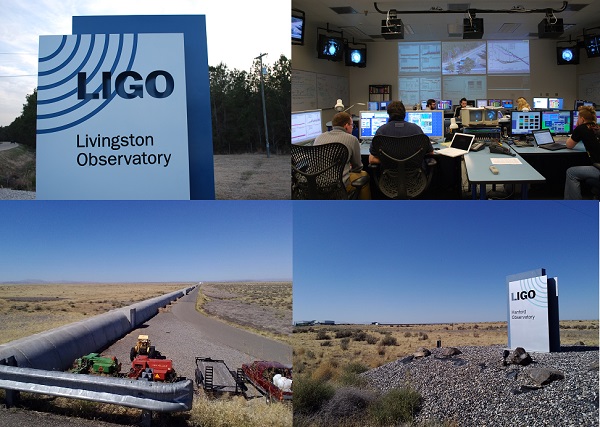
Dave Dickinson
The survey recommends continued investment in the Laser Interferometer Gravitational-Wave Observatory (LIGO), along with preparations for a next-generation facility. And the report advocates further study of high-energy neutrinos, as part of the multi-messenger theme. To this end, the IceCube-Generation 2 Neutrino Observatory would supersede Ice Cube in the Antarctic, with a capability to resolve discrete sources and detect neutrinos at higher energies.
NASA’s highest priority is its space-based ability to catch fleeting events of all kinds as they happen, which requires simultaneous detections of phenomena across multiple wavelengths, as well as via neutrinos and gravitational-waves. To this end, the report recommends the agency pursue one “probe” mission per decade, with a cost cap of $1.5 billion, filling the gap between smaller “explorer” missions and giant flagships.
The report also cites a need to increase the National Science Foundation’s funding to ensure foundations for future astronomical research, including everything from support for early-career scientists to storage of the torrent of astronomical data. To this end, the report recommends NSF fund an additional $16.5 million (an increase of 30%) in grants for individual researchers by 2028.
Of course, there are some cuts and considerations that will come to pass as a result of the survey: One prime example is the SOFIA flying infrared observatory, which NASA has said will cease operations by 2023; the report endorses that decision.
Finally, the decadal survey notes that the rise of satellite megaconstellations, including SpaceX’s Starlink, will not only exponentially increase the number of objects in low-Earth orbit but will also severely impact and degrade the capabilities of all-sky surveys unless regulations are implemented.
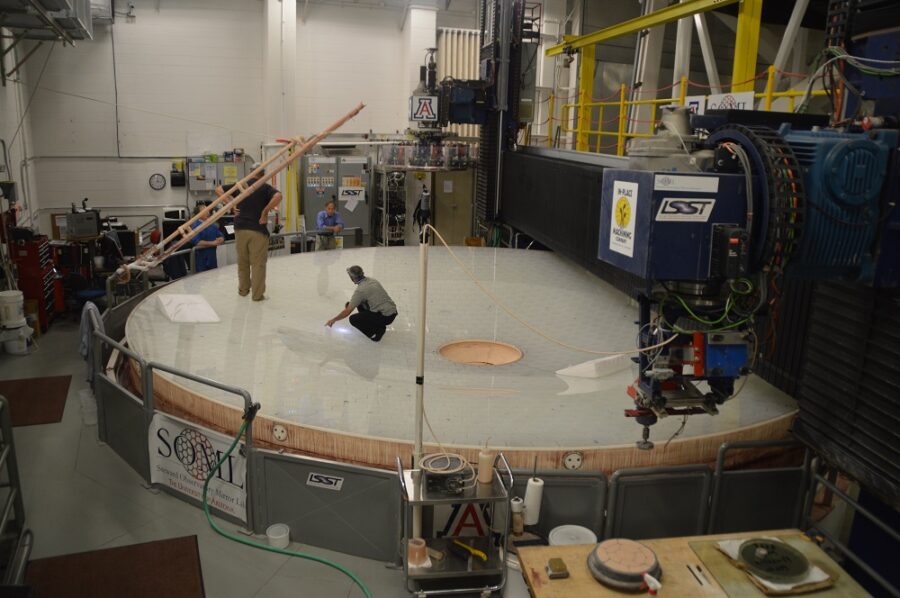
Dave Dickinson
As the seventh in a sequence of decadal surveys that has guided the development of NASA's Great Observatories, this report captures a unique snapshot and vision of the future of the field, not only its exciting potential for discoveries, but also the backdrop of societal and cultural change under which exploration of the cosmos occurs.
 8
8









Comments
Peter Wilson
November 5, 2021 at 12:10 pm
Why keep throwing money at “dark energy” (Λ)? What is needed is the Scientific Method: the addition of complicating factors when the simplest model fails to comport with observations.
A recent article on phys.org forms the starting point: “Black holes grow along with the expansion of the universe.” (3) The reason? Black-hole-growth = local-collapse. And local-collapse is “action,” which must induce a “reaction” in the opposite direction: expansion. Mathematically:
Λ = η/(R_i)^2
The factors on the right-hand-side, and the role they play in cosmology, are diagrammed in the preprint (1) and video (2). The above equation yields the observed value of “dark energy,” 10^-52 /m^2.
1. Causality in Cosmology, https://vixra.org/pdf/1407.0110v1.pdf
2. Dark Energy Dialogue, https://youtu.be/4goInwbOix4
3. https://phys.org/news/2021-11-expansion-universe-impacts-black-hole.html
You must be logged in to post a comment.
Peter Wilson
November 8, 2021 at 8:35 am
Mr. Wilson,
The Scientific Method includes a step called “peer review.” It is literally impossible that generations of scientists—each examining the other’s work for error—have overlooked something important. We do not need to look at your work; we already know it can’t be right. Your equation must be coincidence.
You must be logged in to post a comment.
Andrew James
November 15, 2021 at 6:07 pm
"The Scientific Method includes a step called “peer review.”
Since when? Selling junk science is one thing, but not understanding even the basics of science augurs sheer incompetence. Regardless, denialism with cognitive dissonance means you'll believe whatever you want without any kind of needed rationality. Also countering your own fallicies looks quite desperate to me. Few will be fooled, methinks.
You must be logged in to post a comment.
Andrew James
November 14, 2021 at 9:42 pm
Just rubbish. QM has destroyed the Stone Age.
You must be logged in to post a comment.
Randy Schmid
November 5, 2021 at 4:31 pm
Mr. Wilson’s dark energy model is rational and seems to be a better fit than the current models. That’s what better models should do.
You must be logged in to post a comment.
John
November 6, 2021 at 4:50 pm
Ok, I know I'll get hammered for this but what the hell does diversity have to do with SCIENCE? Are good people being rejected because of the amount of melanin in their skin? This bovine excrement that has NO PLACE in science. The best and the brightest - not quota-driven! Aren't there enough laws in place already to handle issues like harassment??
You must be logged in to post a comment.
Anthony Barreiro
November 8, 2021 at 1:44 pm
Intentional discrimination is not the only thing that keeps smart, motivated people out of careers in astronomy and other STEM fields. To become a professional scientist, you need an excellent education, career counseling, mentoring, and financial support at every step on the career ladder. It helps a lot if you have role models when you're growing up and see people who look like you in your classes, seminars, and laboratories when you get to college and graduate school.
Legal sanctions for sexual harassment only punish perpetrators after the damage is done. That's necessary, but we need to prevent harassment in the first place, and deal proactively with the vast majority of instances of harassment which might not be severe enough to warrant criminal charges or a lawsuit, but which nonetheless push women out of otherwise promising careers.
Identifying and eliminating barriers that prevent people from pursuing the dream of becoming scientists will allow more of "the best and brightest" to make their greatest possible contribution to human knowledge and to solving the grave problems facing our world. As the late Senator Paul Wellstone said, "we all do better when we all do better."
You must be logged in to post a comment.
syrtis major
January 5, 2022 at 10:41 am
My forebears back in the early 19th century were illiterate farm laborers, mill workers and servant girls. My grandfather had some high school education in the 1890's. He sold fruit and vegetables. I have a PhD in Applied Math from Harvard.
There are 50-100 million disadvantaged people in this country. Do the math.
You must be logged in to post a comment.
You must be logged in to post a comment.